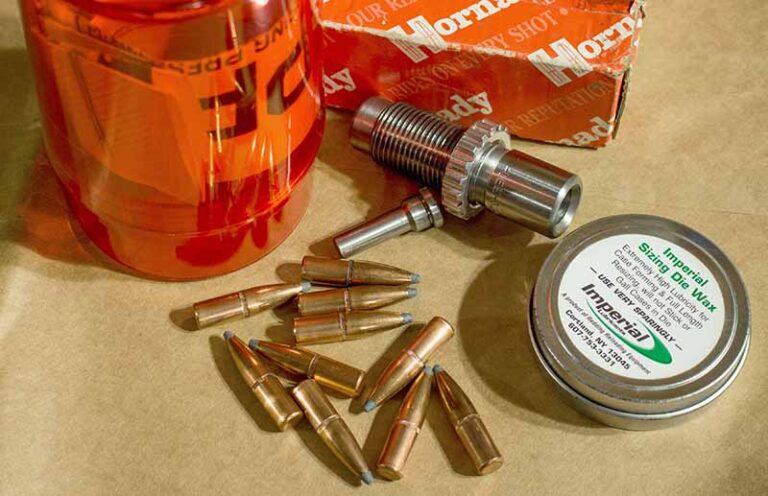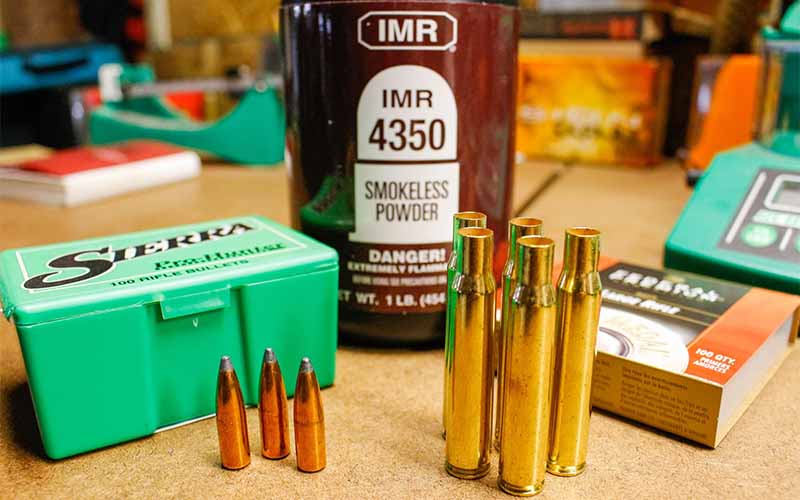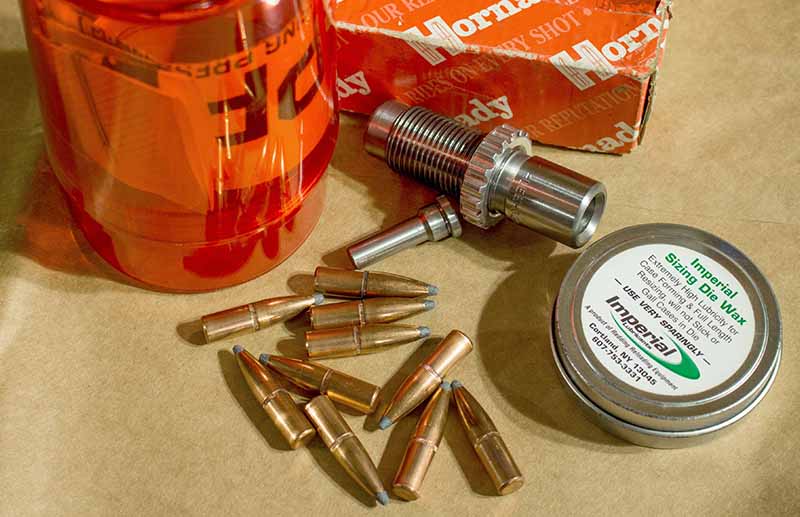
Why old-school projectiles remain a valuable resource to reloaders in the 21st century.
I truly enjoy shooting and hunting with the latest bullet technology, and I’ve written many times that we’re in the Golden Age of projectile development. Monometal copper bullets, hybrid ogive designs and bonded cores are all great … but they aren’t always necessary. Sometimes, an older, classic design fits the bill perfectly—and might even be desirable.
The classics are “classics” for a reason. They’ve proven themselves for generations, and so long as the application is suitable, they function just fine. Of course, some of the simpler designs showed their limits and resulted in the recommended cartridge and caliber minimums we’ve all become familiar with. However, when you stay within the parameters of the projectile’s design, you can see the merits of that particular bullet.

affordable, high-volume shooting. Photo: Massaro Media Group.
The Ol’ Cup-And-Core
The cup-and-core bullet design—for both rifles and handguns—hearkens back to the 1880s yet remains a perfectly viable choice for both hunting and defensive work. It’s a simple concept, with a lead core wrapped in a copper jacket, usually with a bit of exposed lead at the meplat to initiate expansion for the hunting bullets, or perhaps completely encapsulated in the case of the full metal jacket, military-style rifle.
In the rifle world, the Remington Core-Lokt is a great example of a bullet still in use today, and it still works great when used at reasonable velocities on suitable game species. In cartridges like the .30-30 Winchester, .257 Roberts, 7mm Mauser and .30-06 Springfield—where velocities are reasonable—a cup-and-core design will suit just fine, especially if of proper sectional density. The light-for-caliber rifle bullets tend to be frangible, especially if pushed too fast.
From the reloading perspective, I like this bullet style for cartridges that have minimal case capacity. The lead core keeps the bullet length down, and many of the older designs have a shorter ogive; this combination allows for more room in the case, and less bullet outside the case mouth. The .308 Winchester, .300 Winchester Magnum (I do prefer bullets with thicker jackets for this application), .350 Remington Magnum, and .260 Remington will all be easier to load with the shorter cup-and-core projectiles. The Sierra GameKing and ProHunter, Speer Hot-Cor, Hornady InterLock and aforementioned Core-Lokt are all hell on deer and similarly sized game … and wonderfully affordable.
I also like the cup-and-core bullet design for fueling obscure cartridges. As just one example, to feed my .318 Westley Richards—which uses a .330-inch-diameter bullet—I bought a Lee Classic Bullet Sizing Kit, sized for .329-inch-diameter bullets. With a liberal application of Imperial Sizing Die Wax and some heaving and shoving on the Redding Ultra Mag reloading press, I can swage Hornady’s .338-inch-diameter 250-grain Interlock cup and core bullets down to 0.330 inch. There seems to be 0.001 inch of spring-back, as the resultant bullets measure 0.330 inch on two different sets of calipers. All this lets me keep the old cartridge alive.
One of the biggest complaints about cup-and-core rifle bullets is jacket/core separation. Upon impact, the jacket peels away from the core, resulting in poor penetration. This is a common phenomenon among boat-tail bullets, especially at higher velocities. This condition is also what prompted John Nosler to build a better mousetrap; his .300 H&H Magnum was a bit too fast for the bullets of the 1940s, and blew up on a moose’s shoulder. If you run a magnum cartridge, I suggest a thick jacket and plenty of bullet weight.

Jacketed Hollow-Points
On the handgun front, the old-school bullets can be an effective, highly affordable and clean choice. The jacketed hollow-point has long been relied upon for defensive work and will give great penetration without breaking the bank. Hornady’s XTP and XTP Mag and Sierra’s Sportsmaster are still great choices and can serve for target work, defensive needs and as a hunting bullet. They have a good cannelure, or crimping groove, and they’ll withstand magnum velocities.
For those who prefer to avoid lead vapors, the tried-and-true FMJ, TMJ or encapsulated bullet makes a great choice. You'll need to be a bit more careful with the crimp—I prefer a good taper crimp for the autoloading cartridges—as you can bulge the case or damage the bullet when using a roll crimp without a cannelure.
Another point to keep in mind when it comes to handgun bullets: some are plated instead of jacketed. Make sure you use the proper load data for the specific type of bullet you’re loading, as confusing the two can lead to pressure issues, and no one needs that.

Lead Is Timeless
Lead projectiles are as old as cartridges themselves and can make a great option for the reloader to create cheap and effective ammunition, in both rifle and handgun cartridges. You can buy cast lead bullets or grab a mold and cast your own; I like a bit of antimony to keep things a bit cleaner in the barrel. Some of the lead projectiles are wrapped in a polymer coating—like Federal’s Syntech—to minimize fouling as well as lead vapor in an enclosed environment.
Using a cast lead bullet for practice is perfect means for becoming proficient with your handgun. If you want to put time in with your .454 Casull, without the associated pounding, load up some 255-grain cast lead loads at .45 Colt specs and head to the range. Cheap wadcutters are great for the EDC wheelguns; my S&W Model 36 happily digests all the cast wadcutters I can feed it, making practice much less expensive. If you want to try to minimize lead fouling, and even out velocities a bit, a gas check is a great idea.
While there are plenty of applications for a premium bullet—from thick-skinned animals to targets measured in miles—there’s still plenty of space for a classic design. With the price of ammunition and components constantly on the rise, perhaps it’s high time to take another look at the more affordable choices for our reloading.
Editor's Note: This article originally appeared in the November 2023 issue of Gun Digest the Magazine.
More On Reloading:
- Tips For Reloading the .30-06 Springfield
- Loving Your Luger: Reloading the 9mm Luger
- Handloading: Tips For Reloading The 7mm Rem Mag
- How To: Tips For Reloading the .223 Remington
- Reloading Bench: The Inside On Reloading For The .30-30 Winchester

Next Step: Get your FREE Printable Target Pack
Enhance your shooting precision with our 62 MOA Targets, perfect for rifles and handguns. Crafted in collaboration with Storm Tactical for accuracy and versatility.
Subscribe to the Gun Digest email newsletter and get your downloadable target pack sent straight to your inbox. Stay updated with the latest firearms info in the industry.

![Best Concealed Carry Guns In 2025 [Field Tested] Wilson Combat EDC X9S 1](https://gundigest.com/wp-content/uploads/Wilson-Combat-EDC-X9S-1-324x160.jpg)


![Best 9mm Carbine: Affordable PCCs [Tested] Ruger Carbine Shooting](https://gundigest.com/wp-content/uploads/Ruger-Carbine-Shooting-100x70.jpg)
![Best AR-15: Top Options Available Today [Field Tested] Harrington and Richardson PSA XM177E2 feature](https://gundigest.com/wp-content/uploads/Harrington-and-Richardson-PSA-XM177E2-feature-100x70.jpg)
